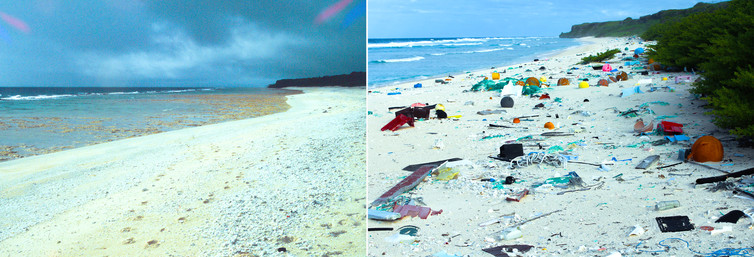A few weeks ago, the world woke to the story of Henderson Island, the “South Pacific island of rubbish”. Our research revealed it as a place littered with plastic garbage, washed there by ocean currents.
This was a story we had been waiting to tell for more than a year, keeping our discoveries under wraps while we worked our way through mountains of data and photographs.
Everyone wanted to know how the plastic got there, and fortunately that is a question that our understanding of ocean currents can help us answer. But the question we couldn’t answer was: when did it all start to go so wrong?
This is the million-dollar question for so many wild species and spaces — all too often we only notice a problem once it’s too big to deny, or perhaps even solve. So when did Henderson’s sad story start? The answer is: surprisingly recently.
An eloquent photo
During our research we had reached out to those who had previously worked on Henderson Island or in nearby areas, to gain a better understanding of what forces contributed to the enormous piles of rubbish that have floated to Henderson’s sandy beaches.
Then, after our research was published and the world was busy reading about 37 million plastic items washed up on a remote south Pacific island, we received an email from Professor Marshall Weisler from the University of Queensland, who had seen the news and got in touch.
In 1992, he had done archaeological surveys on Henderson Island. The photos he shared from that expedition provided a rare glimpse into the beginning of this chapter of Henderson Island’s story, before it became known as “garbage island”.

There are only 23 years between these two photos, and the transformation is terrifying — from pristine South Pacific gem to the final resting place for enormous quantities of the world’s waste.
Remember, this is not waste that was dumped directly by human hands. It was washed here on ocean currents, meaning that this is not just about one beach — it shows how much the pollution problem has grown in the entire ocean system in little more than two decades.
To us, Henderson Island was a brutal wake-up call, and there are undoubtedly other garbage islands out there, inundated and overwhelmed by the waste generated in the name of progress. Although the amount of trash on Henderson is staggering — an average of 3,570 new pieces arrive each day on one beach alone — it represents a minute fraction of the rubbish produced around the globe.
Cleanup confounded
In the wake of the story, the other big question we received (and one we should have seen coming) was: can I help you clean up Henderson Island? The answer is no, for a very long list of reasons — some obvious, some not.
To quote a brilliant colleague, what matters is this: if all we ever do is clean up, that is all we will ever do. With thousands of new plastic items washing up on Henderson Island every day, the answer is clear.
The solution doesn’t require travel to a remote island, only the courage to look within. We need to change our behaviour, to turn off the tap and stem the tide of trash in the ocean. Our oceans, our islands, and our planet demand, and deserve it.
However difficult those changes may be, what choice do we have?
Prevention, not cure
While grappling with the scale of the plastics issue can at times be overwhelming, there are simple things you can do to make a difference. The solutions aren’t always perfect, but each success will keep you, your family, and your community motivated to reduce plastic use.
First, ask yourself this: when did it become acceptable for something created from non-renewable petrochemicals, extracted from the depths of the Earth and shipped around the globe, to be referred to as “single use” or “disposable”? Your relationship with plastic begins with the language you use.
But don’t stop there: here are a couple of facts illustrating how you can challenge yourself and make a difference.
Australians throw away an estimated 30 million plastic toothbrushes every year.
- Challenge: switch to bamboo toothbrushes, which cost just a few dollars each and are available from a range of online retailers or wholefood shops.
A single bottle of typical exfoliating face or body scrub contains 300,000 plastic microbeads.
- Challenge: switch to products that use crushed apricot kernels, coconut shell, coffee grounds, or sea salts as natural exfoliants.
These are only small changes, and you can undoubtedly think of many more. But we need to start turning the tide if we are to stop more pristine places being deluged with our garbage.
This article was republished from The Conversation under a CC BY-ND 4.0 license. Read the original article here.![]()
![]()
Read more: Environment














Tyee Commenting Guidelines
Comments that violate guidelines risk being deleted, and violations may result in a temporary or permanent user ban. Maintain the spirit of good conversation to stay in the discussion.
*Please note The Tyee is not a forum for spreading misinformation about COVID-19, denying its existence or minimizing its risk to public health.
Do:
Do not: